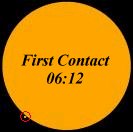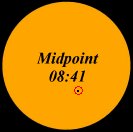The Transit of Mercury: Thursday 9th November, 2006
Back to Index of Informative Articles by Members
By Lachlan MacDonald, 2006
On the morning of Thursday 9th November 2006, for the first time since 17 May 2003, Mercury’s dark silhouette passed across the face of the Sun in an event which occurs only 13 times each century: A Transit of Mercury.
WARNING: IT IS EXTREMELY DANGEROUS TO LOOK AT THE SUN. SERIOUS EYE DAMAGE MAY RESULT.
What Is A Transit?
A transit is when one of the two inner planets (Mercury and Venus) passes precisely between the Earth and the Sun, similar to when the Moon passes between the Earth and the Sun during a Solar Eclipse, although on a very much smaller scale. The result is a small dark spot slowly moving across the face of the Sun. As the two inner planets are much further away from the Earth, they appear much smaller, which is why the transit appears only as a small black spot, as opposed to the Moon almost entirely blocking out the Sun during a Solar Eclipse.
A transit will not always occur when Mercury or Venus passes between the Earth and the Sun, as they will usually they pass either above or below the Sun, as viewed from Earth. Transits of Mercury are quite rare, occuring only 13 times per century, in either May or November. Don’t worry too much if you missed this transit as there will be another one visible on 9 May 2016, 11 November 2019, or for Australian observers, in the afternoon of 13th November 2032.
The 2006 Transit
The transit of Mercury in 2006 was the first since 2003. Eastern Australian observers were able to observe the entire transit, however for observers in Western Australia, South Australia and Northern Territory the Sun rose after the beginning of the transit.
The table below provides times of the transit for the capital cities in Australia: (All times are local time, including Daylight Savings Time where applicable).
| Location | Sunrise | Contact I | Contact II | Contact III | Contact IV |
| Adelaide | 06:07 | -- | -- | 10:39 | 10:41 |
| Brisbane | 04:53 | 05:12 | 05:14 | 10:08 | 10:10 |
| Canberra | 05:54 | 06:12 | 06:14 | 11:09 | 11:10 |
| Darwin | 04:42 | -- | -- | 09:39 | 09:41 |
| Hobart | 05:45 | 06:12 | 06:14 | 11:09 | 11:10 |
| Melbourne | 06:06 | 06:12 | 06:14 | 11:09 | 11:10 |
| Perth | 05:13 | -- | -- | 08:09 | 08:11 |
| Sydney | 05:48 | 06:12 | 06:14 | 11:08 | 11:10 |
The “Black Drop” Effect
Precise timing of the second (and third) contact can be difficult due to the “black drop” effect, where a dark thread appears to join the edges of Mercury and the Sun making the exact timing of second and third contact difficult to establish.
There are many explanations for the black drop effect. In previous years, it was believed by some that this effect was due to the atmosphere of Venus or Mercury (thus an illusion), however, as Venus' atmosphere is too thin to be responsible, and Mercury's atmosphere virtually non-existent, we now know that it is not an illusion. The “black drop effect” has recently been photographed by the TRACE spacecraft during previous transits of Mercury. Recent explanations suggest the black drop effect may be a combination of blurring caused by the Earth’s atmosphere, with the dimming of the Sun’s disc close to its edge.
How Do I View The Transit Safely?
WARNING - OBSERVING THE SUN IS EXTREMELY DANGEROUS. DO NOT LOOK DIRECTLY AT THE SUN, UNLESS YOU ARE USING AN APPROVED SOLAR FILTER OR WEARING PROPER "ECLIPSE SUNGLASSES" SPECIALLY DESIGNED TO PROTECT YOUR EYESIGHT.
The best way to observe the transit safely is to visit your local amateur astronomical society, observatory or planetarium. These groups are likely to be running public viewing sessions for the transit.
With Mercury being such a small planet, a powerful telescope will be needed if you want to observe the transit safely yourself, using the telescope to project an image of the sun onto a large flat surface. NOTE: DO NOT LOOK THROUGH THE TELESCOPE OR THE FINDERSCOPE but, instead, use the shadow of the telescope to aim it directly at the sun, and you should see the Sun’s bright disc projected onto the flat surface.
You may need to adjust the focus of the projected image, until the tiny black spot of Mercury can be seen clearly and sharply. The spot will only be about 1/194th of the Sun’s diameter, however should still be seen. Viewing the projected image using this method is quite safe, however looking through the telescope will cause instant blindness. DO NOT LEAVE THE TELESCOPE UNATTENDED ESPECIALLY WHEN CHILDREN ARE PRESENT.
What Will I See?
For observers with a proper Solar Filter, a magnified view of the Sun through a telescope will show the silhouette of Mercury slowly moving across the face of the Sun. For many, the most interesting part of the transit will be the 2 minutes between first and second contact, as Mercury “enters” the solar disc.
During the 2006 transit (for Eastern Australian observers) there will be four moments when the disc of Mercury comes into contact with the Sun at a single point. First contact will occur just as Mercury initially touches the solar disc. Second contact is at the exact second when Mercury has fully “entered” the Sun’s disc. Third Contact is at the exact second when Mercury touches the edge of the Sun's disc on its way out, and Fourth Contact is the exact second when Mercury leaves the edge of the Sun's disc.






